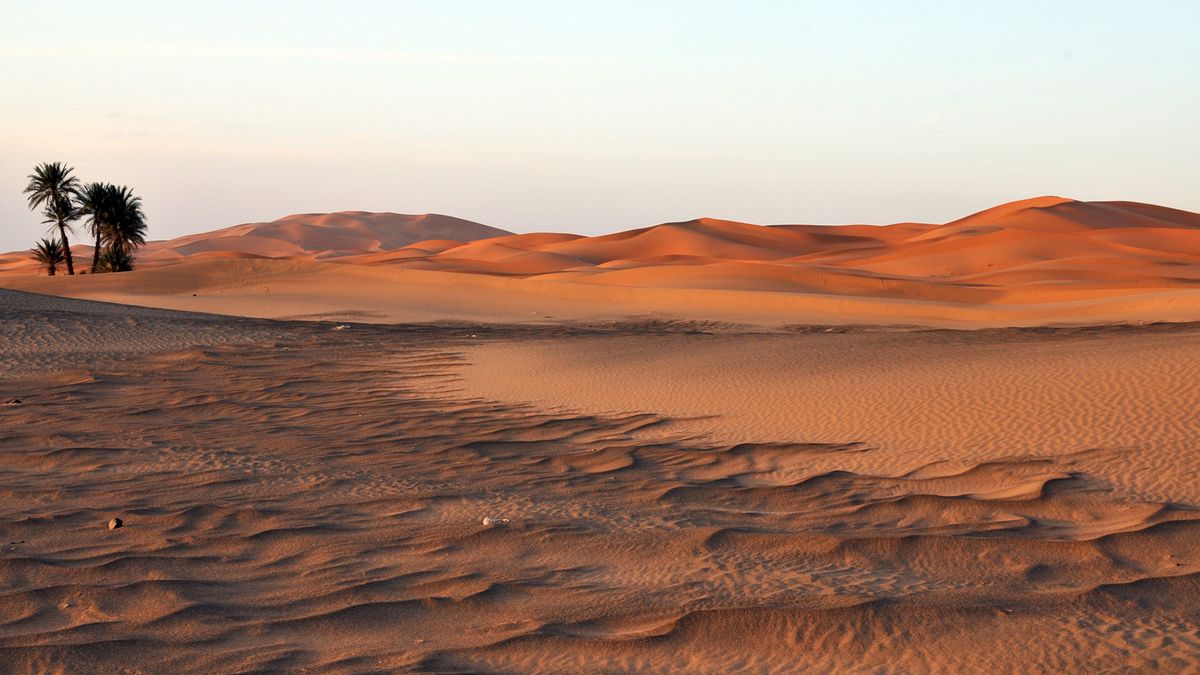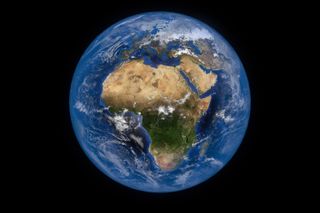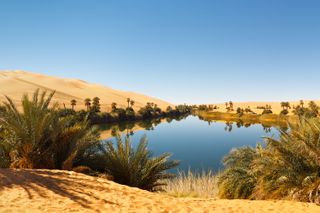The Sahara: Earth's largest hot desert
One of the harshest environments on Earth, the Sahara is most famous for its sprawling sand dune fields.

The Sahara is the largest hot desert in the world and the third-largest desert overall, behind the cold deserts of Antarctica and the Arctic. The Sahara is one of the harshest environments on Earth, covering 3.6 million square miles (9.4 million square kilometers), an area about the size of the United States (including Alaska and Hawaii) and spanning nearly a third of the African continent. The name of the desert comes from the Arabic word ṣaḥrāʾ, which means "desert," according to the Encyclopedia Britannica.
What's the geography of the Sahara?
The Sahara is bordered by the Atlantic Ocean to the west, the Red Sea to the east, the Mediterranean Sea to the north and the Sahel savanna to the south. The enormous desert spans 10 countries (Algeria, Chad, Egypt, Libya, Mali, Mauritania, Morocco, Niger, Sudan and Tunisia) as well as the territory of Western Sahara, a former Spanish colony that was annexed by Morocco in 1975, though control of the region is disputed by the Indigenous Saharawi people, the BBC reported in 2021.
The Sahara desert has a variety of land features, but it is most famous for the sand dune fields that are often depicted in movies. The dunes can reach almost 600 feet (183 meters) high, and they cover about 25% of the entire desert, according to the Encyclopedia Britannica. Other topographical features include mountains, plateaus, sand- and gravel-covered plains, salt flats, basins and depressions. Emi Koussi, an extinct volcano in Chad, is the highest point in the Sahara, reaching 11,204 feet (3,415 m) above sea level, and the Qattara Depression in northwestern Egypt is the Sahara's deepest point, at 436 feet (133 m) below sea level.
Although water is scarce across the entire region, the Sahara contains two permanent rivers (the Nile and the Niger), as well as at least 20 seasonal lakes and huge aquifers, which are the primary sources of water for more than 90 major oases in the desert. Water management authorities once thought that the aquifers in the Sahara were "fossil aquifers" — water reserves that accumulated under different climate and geological conditions in the distant past — and feared that these resources would soon dry up due to overuse. However, a study published in the journal Geophysical Research Letters in 2013 discovered that the aquifers were still being fed via rain and runoff.

What kinds of plants and animals live here?
Despite the harsh, arid conditions of the Sahara, many plant and animal species call the region home. Approximately 500 plant species, 70 mammalian species, 90 avian species, 100 reptilian species and numerous species of spiders, scorpions and other small arthropods live in the Sahara, according to the World Wildlife Fund.
The camel is one of the most iconic animals of the Sahara, though its ancestors originated in North America. The ancestors of modern camels first appeared about 45 million years ago, and the large mammals eventually made their way to the African continent by traveling across the Bering isthmus between 3 million and 5 million years ago, according to a study published in 2015 in the Research Journal of Agriculture and Environmental Management. Camels were domesticated about 3,000 years ago on the southeast Arabian Peninsula, to be used for transportation in the desert, according to the University of Veterinary Medicine Vienna.
Camels, also known as the "ships of the desert," are well adapted to the Sahara's hot, arid environment, according to the San Diego Zoo. The humps on a camel's back store fat, which can be used for energy and hydration in between meals. Camels store energy so efficiently that they can go more than a week without water and several months without food.
Other mammal residents of the Sahara include gazelles, addaxes (a type of antelope), cheetahs, caracals, desert foxes and wild dogs. Many reptiles also thrive in the desert environment, including several species of snakes, lizards and even crocodiles in places where there is enough water. Several arthropod species also call the Sahara home, such as dung beetles, scarab beetles, "deathstalker" scorpions and many types of ants, according to the Sahara Conservation Fund.
Plant species in the Sahara have adapted to the arid conditions, with roots that reach deep underground to find buried water sources and leaves that are shaped into spines that minimize moisture loss, according to the BBC. The most arid parts of the desert are completely devoid of plant life, but oasis areas, such as the Nile Valley, support a large variety of plants, including olive trees, date palms and various shrubs and grasses.

What's the climate like in the Sahara?
Today, the Sahara has a dry, inhospitable desert climate. However, it alternates between harsh desert and another extreme — a lush, green oasis — every 20,000 years, according to a study published in 2019 in the journal Science Advances. The study's authors examined marine sediments containing dust deposits from the Sahara from the past 240,000 years. They found that the cycle between a dry and a green Sahara corresponded to the slight changes in the tilt of Earth's axis, which also drives monsoon activity. When Earth's axis tilted the Northern Hemisphere just a single degree closer to the sun (about 24.5 degrees instead of today's 23.5 degrees), it received more sunlight, which increased the monsoon rains and, therefore, supported a lush, green landscape in the Sahara.
Archaeologists have discovered prehistoric cave and rock paintings and other archaeological remains that shed light on what life was like in the once-green Sahara. Bits of pottery suggest that about 7,000 years ago, herders raised livestock and harvested plants in what now is an arid desert.
But for the past 2,000 years or so, the climate of the Sahara has been fairly stable — and dry. The northeastern winds strip moisture from the air over the desert and drive hot winds toward the equator. These winds can reach exceptional speeds and cause severe dust storms that can drop local visibility to zero. Dust from the Sahara travels on trade winds all the way to the opposite side of the globe.
Precipitation in the Sahara ranges from zero to about 3 inches (7.6 centimeters) of rain per year, researchers reported in 2014 in the journal American Meteorological Society. Occasionally, snow falls at higher elevations. Year-round, temperatures in dry, arid deserts such as the Sahara are about 60 to 77 degrees Fahrenheit (20 to 25 degrees Celsius) on average, soaring as high as 120 F (49 C) in the summer during the daytime and plummeting to 0 F (minus 18 C) during the winter at night, according to the University of California Museum of Paleontology Berkeley (UCMP).

Is climate change affecting the Sahara?
The area of the Sahara desert has grown nearly 10% since 1920, according to a 2018 study published in the Journal of Climate, and the desert will likely continue to expand at a comparable rate until 2050, according to another study, published in 2020 in the journal Scientific Reports. Although all deserts, including the Sahara, increase in area during the dry season and decrease during the wet season, human-caused climate change, in conjunction with natural climate cycles, is causing the Sahara desert to grow more and shrink less over time. The 2018 study's authors estimated that approximately a third of the desert's expansion was due to human-driven climate change.
One proposal for mitigating the effects of climate change is to install large-scale wind and solar farms in the Sahara. The farms would provide clean energy and reduce the amount of greenhouse gases entering the atmosphere, and may also promote increased precipitation in the vicinity, according to a 2018 study published in the journal Science. Simulations showed that precipitation over wind farms would double, on average, thereby increasing vegetation by an estimated 20%. The solar farm simulations produced similar results.
Additional resources
Discover what the Sahara was like millions of years ago, during the Cretaceous period, in this 2019 study in the journal Bulletin of the American Museum of Natural History. Find out more about one of the desert's most striking landscape features today, the Aïr Mountains in central Niger, in a case study from the U.S. Geological Survey. Visit the Sahara with Sir David Attenborough, to learn about the extreme adaptations that enable animals to survive the desert's harsh conditions, in an episode of the BBC One documentary, "Africa."
BIBLIOGRAPHY
Gonçalvès, J., et al. “Quantifying the Modern Recharge of the ‘Fossil’ Sahara Aquifers.” Geophysical Research Letters, vol. 40, no. 11, 2013, pp. 2673–2678., https://doi.org/10.1002/grl.50478.
“Northern Africa.” WWF, World Wildlife Fund, https://www.worldwildlife.org/ecoregions/pa1327.
Introduction to Camel Origin, History, Raising ... (PDF) https://www.researchgate.net/publication/284898592_Introduction_to_Camel_origin_history_raising_characteristics_and_wool_hair_and_skin_A_Review.
“Origin of Dromedary Domestication Discovered.” Vetmeduni, https://www.vetmeduni.ac.at/en/infoservice/presseinformation/presseinformationen-2016/origin-of-dromedary-domestication-discovered.
“Camel.” San Diego Zoo Wildlife Alliance Animals and Plants, https://animals.sandiegozoo.org/animals/camel.
“Wildlife Conservation Network (WCN).” Sahara Conservation Fund, 18 Sept. 2019, https://www.saharaconservation.org/Wildlife.
Skonieczny, C., et al. “Monsoon-Driven Saharan Dust Variability over the Past 240,000 Years.” Science Advances, vol. 5, no. 1, 2019, https://doi.org/10.1126/sciadv.aav1887.
Twentieth-Century Climate Change over Africa ... - UMD. https://www2.atmos.umd.edu/~nigam/JCLIM.African.Sahara.Desert.Expansion.published.29March2018.pdf.
Liu, Y., Xue, Y. Expansion of the Sahara Desert and shrinking of frozen land of the Arctic. Sci Rep 10, 4109 (2020). https://doi.org/10.1038/s41598-020-61085-0.
Li, Yan, et al. “Climate Model Shows Large-Scale Wind and Solar Farms in the Sahara Increase Rain and Vegetation.” Science, vol. 361, no. 6406, 2018, pp. 1019–1022., https://doi.org/10.1126/science.aar5629.
O'leary, Maureen A., et al. “Stratigraphy and Paleobiology of the Upper Cretaceous-Lower Paleogene Sediments from the Trans-Saharan Seaway in Mali.” BioOne Complete, American Museum of Natural History, https://bioone.org/journals/bulletin-of-the-american-museum-of-natural-history/volume-2019/issue-436/0003-0090.436.1.1/Stratigraphy-and-Paleobiology-of-the-Upper-Cretaceous-Lower-Paleogene-Sediments/10.1206/0003-0090.436.1.1.short.
“West Africa: Land Use and Land Cover Dynamics.” Landscapes of the Sahara Desert | West Africa, https://eros.usgs.gov/westafrica/case-study/landscapes-sahara-desert.
“Africa, Sahara.” BBC One, BBC, 31 Aug. 2019, https://www.bbc.co.uk/programmes/b01qh31v.
This article was updated on Feb. 24, 2022, by Live Science Senior Writer Mindy Weisberger.
Sign up for the Live Science daily newsletter now
Get the world’s most fascinating discoveries delivered straight to your inbox.

Rachel Ross is a science writer and editor focusing on astronomy, Earth science, physical science and math. She holds a Bachelor of Arts in Philosophy from the University of California Davis and a Master's degree in astronomy from James Cook University. She also has a certificate in science writing from Stanford University. Prior to becoming a science writer, Rachel worked at the Las Cumbres Observatory in California, where she specialized in education and outreach, supplemented with science research and telescope operations. While studying for her undergraduate degree, Rachel also taught an introduction to astronomy lab and worked with a research astronomer.
- Mindy WeisbergerLive Science Contributor












